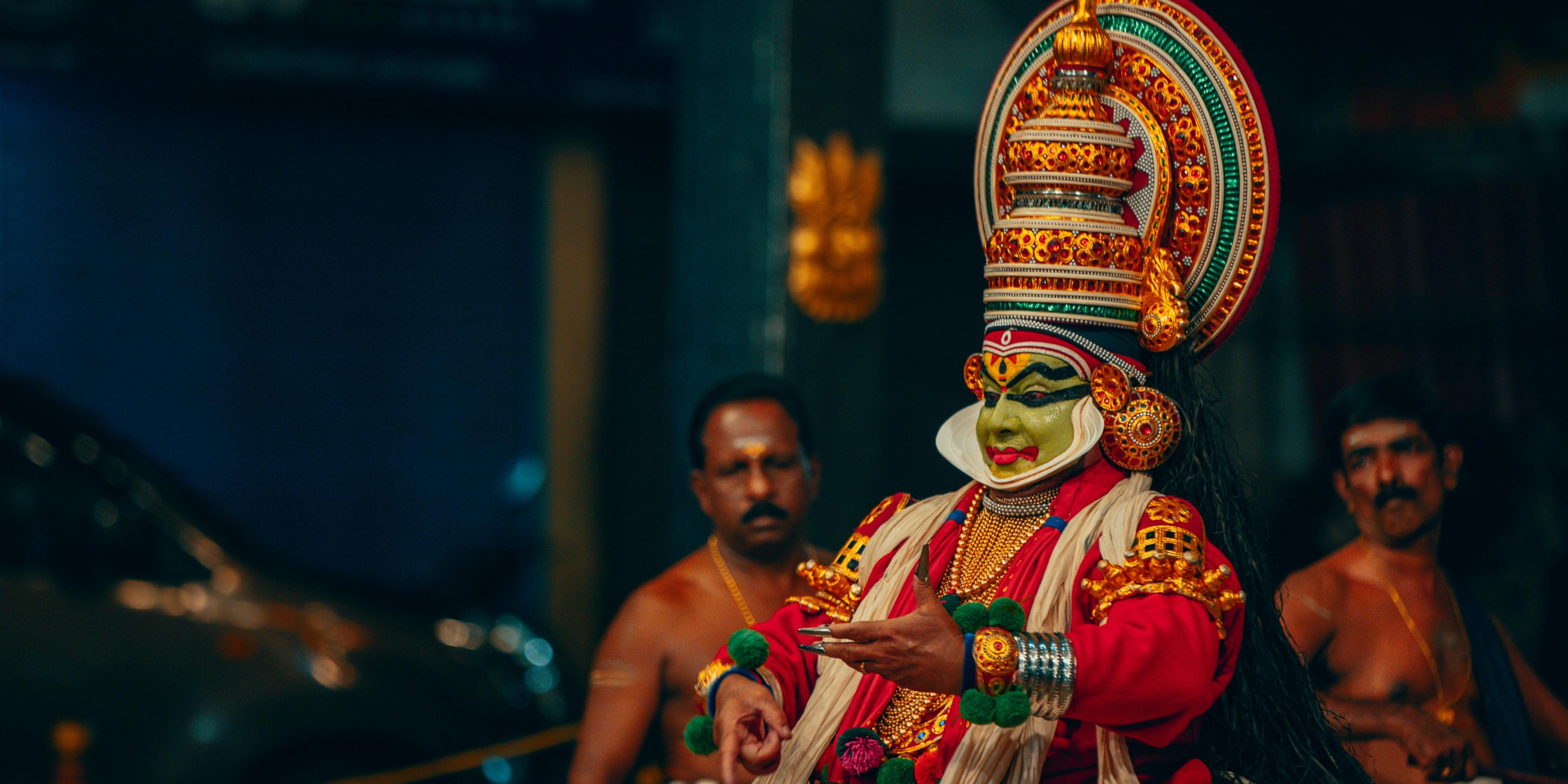The Faces of Gods and Demons: Unmasking the Art of Kathakali

Imagine a world where deities and demons descend to Earth, their stories painted across faces and woven into vibrant costumes. This is the world of Kathakali, a classical dance form from Kerala, where masks and costumes aren't mere accessories, but vessels of ancient power and artistic brilliance.

Close-up of a Kathakali mask highlighting the vibrant colours and intricate details
These masks and costumes embody the very essence of divine and demonic forces. The chuvanna thaadi (red beard), a fiery symbol of raw, untamed power, instantly communicates the character's fierce nature. The soothing paccha (green) signifies nobility and virtue, drawing the audience into a world populated by heroes and gods. This immediate visual language connects viewers to a rich tapestry of mythology and folklore, making the stories come alive with a visceral intensity.

Kathakali dancer in full costume and makeup, striking a pose that showcases the character's nature
The creation of these elaborate ensembles is a testament to the dedication of generations of artisans. Their skilled hands, guided by ancestral knowledge, meticulously craft each mask and costume, ensuring the continuity of sacred traditions. This inherited craft binds communities together, strengthening the threads of shared heritage and preserving a vibrant cultural legacy.
The transformation of the Kathakali actor is a ritual in itself. The application of the elaborate chutti (makeup) and the donning of the costume transcend the mundane, elevating the performer to a divine or demonic embodiment. It's a metamorphosis that blurs the lines between the human and the mythical, connecting both performer and audience to a higher plane of existence.
From the exquisitely embroidered headgears to the heavily layered skirts, every detail speaks volumes about the importance of aesthetics in Kathakali. This commitment to visual splendor transforms the performance into a mesmerizing spectacle, a celebration of beauty and craftsmanship that evokes awe and wonder.

Detail shot of the intricate embroidery and layering of a Kathakali costume
The symbolic language of Kathakali costumes and masks adds another layer of depth to the art form. The colours and designs adhere to a strict code: paccha for the noble, kathi (knife) for the villainous, each thaadi (beard) a marker of specific character traits. Understanding this visual lexicon allows viewers to delve deeper into the narrative and appreciate the rich artistic heritage of Kerala.
Beyond the stage, these larger-than-life figures adorn temples, homes, and public spaces, becoming enduring symbols of cultural identity and artistic excellence. Their omnipresence in daily life fosters a deep sense of pride and belonging within the community.

A Kathakali mask displayed in a home, showcasing its role as a cultural symbol
The art of Kathakali masks and costumes continues to resonate deeply within the cultural landscape of Kerala. Their vibrancy, symbolism, and the dedication of the artisans who create them serve as a powerful reminder of the enduring strength of tradition and the transformative power of art.
Do you have a story about your own encounter with Kathakali or other traditional art forms? Share it with us! If you're passionate about cultural storytelling, consider becoming an author for CraftYug. Reach out to us at team@craftyug.com.
References:
- Zarrilli, Phillip B. Kathakali Dance-Drama: Where Gods and Demons Come to Play. Routledge, 2000.
- Kilimanoor, N. Ramachandran. Kathakali: The Sacred Dance-Drama of Kerala. S. Chand & Company Ltd, 1999.
- Leary, James. “Kathakali.” Asian Theatre Journal, vol. 5, no. 1, 1988, pp. 51–78. JSTOR, www.jstor.org/stable/25161674.
- Indian Heritage: Performing Arts. APH Publishing, 2003.
- Kurup, K. B. “Kathakali.” Sruti, issue 23, 1986, pp. 31-35.
- Observation of Kathakali imagery in Kerala, especially during festivals and cultural events.